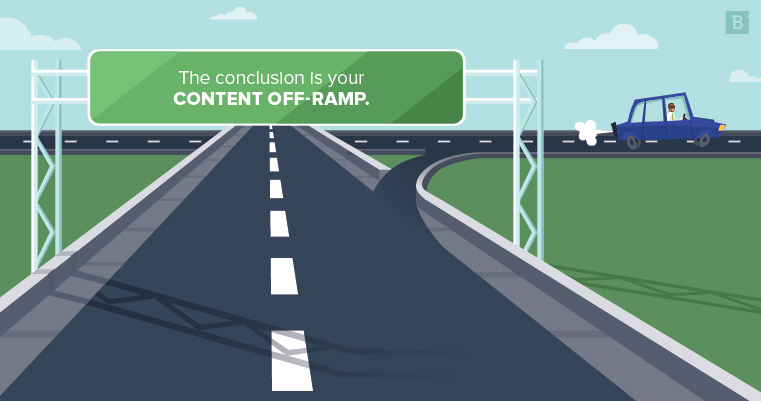You’re probably wondering why conclusions matter. And you have a good reason to ponder.
Industry data doesn’t give you hope to believe anyone will reach the end of your blog content – let alone read a full paragraph. Here are some figures that may spur this assumption:
- In 2017, average bounce rate stood at 58.18 percent. More than half of readers may not even start the article.
- That figure jumped up to 76.47 percent for blogs.
- In all, your readers could spend as little as 80 seconds on your site.
- Lots of articles get social shares, but only 59 percent nab a click-through.
Yet these numbers shouldn’t discourage you from crafting powerful content from beginning to end. They should embolden you to bolster your blogs with richer, well-composed writing so the readers you do entrance remain engaged.

Just as an effective story lead functions like an on ramp to bring readers into the content from their previous locations, conclusions are the off ramp from the blogs and to readers’ next destination or path on your site.
Well-written conclusions ease readers. When you exit an expressway, you don’t suddenly stop or pick up speed, lest you find yourself causing a pileup or flying off the ramp, respectively. A poor conclusion can be just as jarring.
Understand the value of a powerful ending
Who doesn’t love closure? When you see a movie, you want to be just as satisfied with the third act as the first one. We all know how we felt about how Titanic ended things with Jack and Rose or the chagrin some Star Wars fans have about a tribe of teddy bears taking down stormtroopers in Return of the Jedi.
Unsatisfactory endings leave readers feeling cheated out of the experience, especially if they gave the time to reach the end. Additionally, traditional skimming wisdom means a shortfall here can weaken an entire article for speed readers.
Skimming typically means reading the introduction, the first sentence of body paragraphs and the conclusion. With a poor conclusion, a third of this reading experience is subpar.
Moreover, if you include a CTA at the bottom of your blogs, the close needs to transition readers from content that is about addressing their pain points to a graphical appeal to contact you about your products and services. With CTA placement possibly impacting conversion rates as much as 41 percent and color choice alone being able to give a 34 percent boost, you don’t want to cheapen your hard design work with a conclusion that doesn’t resonate.
Close your content with conviction
By now, you’re probably itching to see how this article will close.
Will it include a joke? Will you laugh? Will it start with “It’s not you, it’s me”?
Before we can get there, let’s explore the considerations that went into crafting it. Here are a few tips to help you write a great conclusion:
Bookend the ideas
If any advice about conclusions is prevalent, the call to restate the thesis and main supporting claims is familiar for writers of every scope.
This wisdom appears often because it works. Conclusions bring the ideas of your content together, packaging the key points for readers to take with them.
However, avoid restating word for word or just summarizing. Think about an even more condensed takeaway.
For instance, a recent discussion on sound in writing has a main idea regarding what sonic techniques can do for your content. While the benefits and strategies matter, none of the points prove successful without intent. This conclusion “restated” the idea of paying attention to sound with a recommendation to do just that by reading content aloud.
Address outliers
Strong arguments acknowledge their gaps and counterarguments. Conclusions are a good place to put this information.
This tip doesn’t mean you should contradict your ideas. In fact, you should do just the opposite.
One example is how our advanced web content writing tip articles conclude: They remind you intent matters above all else, and craft techniques are only as effective as the person wielding them.
Extend the conversation
But it’s the end. Why would you want to keep the discussion going?
You can put the final word on your subject, but if you write a targeted argument, your topic will have a multitude of other contexts in which it can exist.
Conclusions give you space to pose questions about these contexts and propose ideas for future study. Plus, such inquiries can serve as springboards for readers to comment and encourage them to come back for your follow-up post.
Just make sure you avoid a rabbit hole best served for full-fledged exploration in another blog.
Include a creative subhead
Strong endings don’t need an announcement. Plus, you’ve spent so much energy on engaging subheads for the body, why let the article end flat with “conclusion” capping it off?
Also, avoid hackneyed language, like “what’s next?” and “wrapping up.”
Be concise
Don’t keep your readers on the off ramp too long. If you feel your conclusion lacks brevity, you may have fallen into summary, or you may need to revisit your argument structure to ensure you addressed all the relevant points in the body.
Know that it doesn’t have to end this way
You’ve made it to the end! By now, you know conclusions have a lot of work to do between wrapping up one piece of content and easing readers to another. As such, conclusions won’t come easily.
However, don’t get caught up in a formula. Tips are tips for a reason, and even tried-and-true advice doesn’t work in every case. Think about real off ramps: Not all of them look like cloverleafs.
With enough intent, you’ll be writing conclusions that rack up CTA clicks and convince disgruntled moviegoers that Jack couldn’t have fit on the door.





